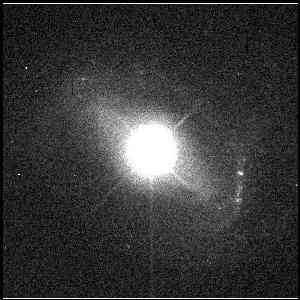


QUASARS

IMAGE - of the Quasar QSO1229+204 taken by the Hubble Space Telescope. The galaxy is much fainter than the very bright nucleus at its centre. It is in collision with the dwarf galaxy to its right. (Acknowledgements to John Hutchings, Dominion Astrophysical Observatory and NASA).
Quasars are usually thought to be galaxies, like the Milky Way, the galaxy in which we live; each galaxy is a huge collection of stars like the Sun. However, quasars have at their centre an extremely bright nucleus which is very small (in astronomer's terms) (see picture above). This nucleus can emit 1000 times as much energy as an entire normal galaxy. Much of it as infra-red light and X-rays. Some are so strong that they can be seen from over 10 billion light years away, at the edge of the Universe. Some have jets of material which extend hundreds of thousands of light years into the space around the galaxy.
Quasars are thought to have a Supermassive Black Hole in the nucleus which is gobbling up stars and other matter, which heats up as gravitational energy is released as it falls in on the nucleus. This forms an accretion disc and possibly also a jet. The accretion disc is very hot and releases a great amount of energy because the Black Hole is so massive - perhaps 1,000,000,000 times the mass of the Sun.
Often quasars are in collision with a dwarf galaxy, as in the picture above. It is thought that this may turn the quasar on by releasing a shower of stars on to the Black Hole.
In the 1950's astronomers started using large radio telescopes like those at Jodrell Bank to study the heavens, and found that what appeared to be faint, ordinary stars were actually emitting large amounts of radio waves so they were named Quasi Stellar Radio Sources or Quasars. Only later was it found that the radio source was in a host galaxy. The radio waves come from the nucleus and the jet, if there is one.

